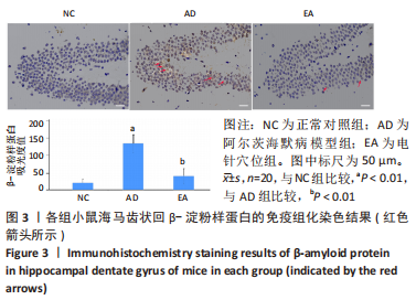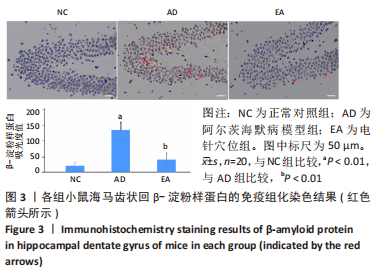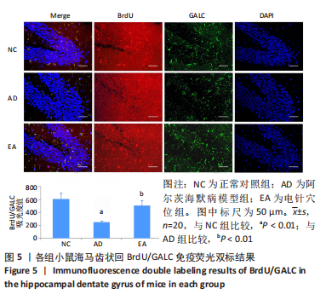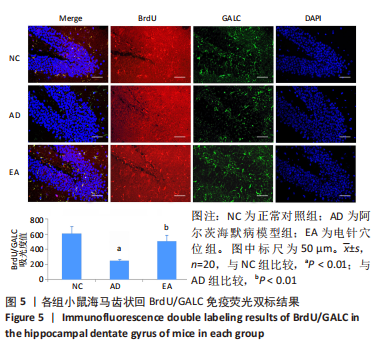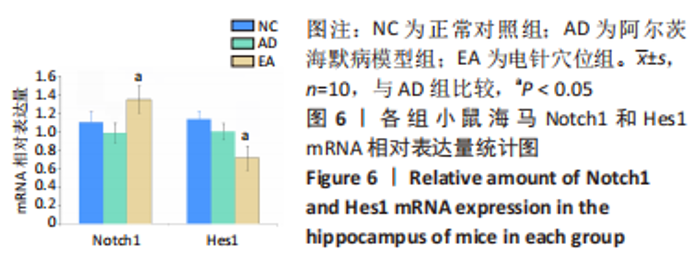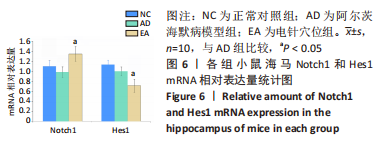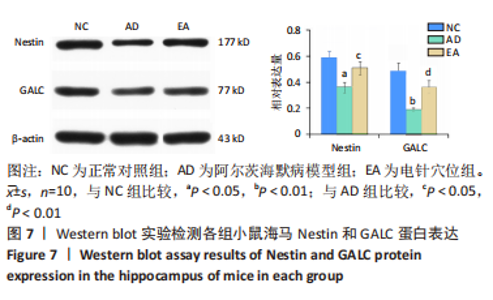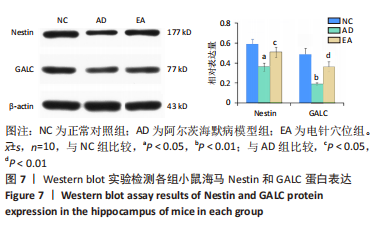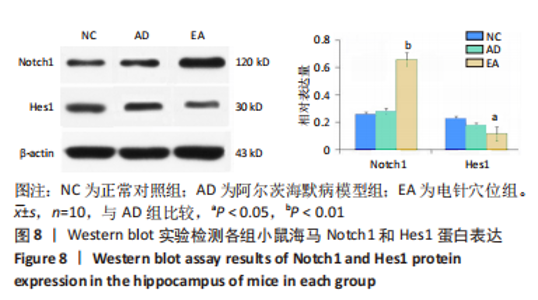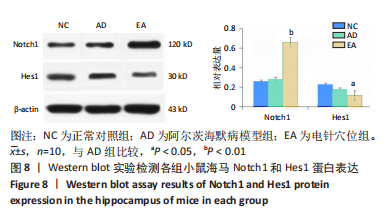Chinese Journal of Tissue Engineering Research ›› 2024, Vol. 28 ›› Issue (7): 1029-1035.doi: 10.12307/2024.110
Previous Articles Next Articles
Electroacupuncture intervention on the proliferation and differentiation of hippocampal neurons and oligodendrocytes in Alzheimer’s disease model mice
Li Longyang, Zhang Songjiang, Zhao Xianmin, Zhou Chunguang, Gao Jianfeng
- School of Medicine, Henan University of Chinese Medicine, Zhengzhou 450046, Henan Province, China
-
Received:2023-01-06Accepted:2023-02-14Online:2024-03-08Published:2023-07-15 -
Contact:Gao Jianfeng, Professor, Master’s supervisor, School of Medicine, Henan University of Chinese Medicine, Zhengzhou 450046, Henan Province, China -
About author:Li Longyang, Master candidate, School of Medicine, Henan University of Chinese Medicine, Zhengzhou 450046, Henan Province, China Zhang Songjiang, Associate professor, Master’s supervisor, School of Medicine, Henan University of Chinese Medicine, Zhengzhou 450046, Henan Province, China -
Supported by:Key Science and Technology Research Project in Henan Province, No. 152102310100 (to ZSJ); Henan Natural Science Foundation, No. 202300410267 (to GJF); Innovation Team Project of Henan University of Chinese Medicine, No. [2016]124 (to GJF)
CLC Number:
Cite this article
Li Longyang, Zhang Songjiang, Zhao Xianmin, Zhou Chunguang, Gao Jianfeng. Electroacupuncture intervention on the proliferation and differentiation of hippocampal neurons and oligodendrocytes in Alzheimer’s disease model mice[J]. Chinese Journal of Tissue Engineering Research, 2024, 28(7): 1029-1035.
share this article
Add to citation manager EndNote|Reference Manager|ProCite|BibTeX|RefWorks
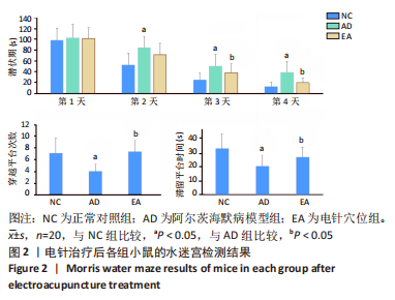
2.1 实验动物数量分析 实验选用雄性C57BL/6J小鼠20只,作为正常对照组,选用阿尔茨海默病模型小鼠40只,随机分为阿尔茨海默病模型组和电针穴位组,每组20只。实验过程中无小鼠死亡,所有小鼠全部进入结果分析。 2.2 各组小鼠Morris水迷宫检测结果 采用Morris水迷宫检测各组小鼠的学习和记忆功能。从图2可以看出,与正常对照组相比,模型组定位航行实验第2,3,4天潜伏期明显延长(P < 0.05),穿越平台次数(P < 0.05)和平台滞留时间明显减少(P < 0.05);与模型组相比,电针穴位组小鼠定位航行实验第3,4天潜伏期明显缩短(P < 0.05),穿越平台次(P < 0.05)和平台滞留时间明显增加(P < 0.05)。同时,随着时间的推移,不论是模型组与正常对照组相比,还是电针穴位组与模型组相比,潜伏期的变化越来越大,到第4天最大。"
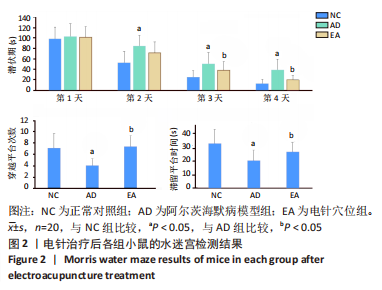
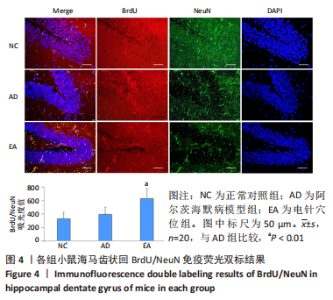
2.4 各组小鼠海马齿状回BrdU/NeuN和BrdU/GALC免疫荧光双标结果 BrdU/NeuN和BrdU/GALC免疫荧光双标检测各组小鼠海马齿状回神经元和少突胶质细胞的增殖情况。从图4可以看出,与正常对照组相比,模型组小鼠海马齿状回BrdU/NeuN的阳性细胞表达没有明显变化(P > 0.05);与模型组相比,电针穴位组小鼠海马齿状回BrdU/NeuN的阳性细胞表达明显增加(P < 0.01)。从图5可以看出,与正常对照组相比,模型组小鼠海马齿状回BrdU/GALC的阳性细胞表达明显减少(P < 0.01);与模型组相比,电针穴位组小鼠海马齿状回BrdU/GALC的阳性细胞表达明显增多(P < 0.01)。"
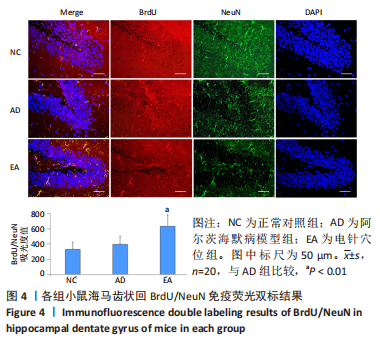
| [1] NASERI NN, WANG H, GUO J, et al. The complexity of tau in Alzheimer’s disease. Neurosci Lett. 2019;705:183-194. [2] LIU R, YANG J, LIU L, et al. An “Amyloid-β Cleaner” for the Treatment of Alzheimer’s Disease by Normalizing Microglial Dysfunction. Adv Sci (Weinh). 2019;7(2):1901555. [3] MOONEN S, KOPER MJ, VAN SCHOOR E, et al. Pyroptosis in Alzheimer’s disease: cell type-specific activation in microglia, astrocytes and neurons. Acta Neuropathol. 2023;145(2):175-195. [4] DEFLITCH L, GONZALEZ-FERNANDEZ E, CRAWLEY I, et al. Age and Alzheimer’s Disease-Related Oligodendrocyte Changes in Hippocampal Subregions. Front Cell Neurosci. 2022;16:847097. [5] ZHANG P, KISHIMOTO Y, GRAMMATIKAKIS I, et al. Senolytic therapy alleviates Aβ-associated oligodendrocyte progenitor cell senescence and cognitive deficits in an Alzheimer’s disease model. Nat Neurosci. 2019;22(5):719-728. [6] CAI M, LEE JH, YANG EJ. Electroacupuncture attenuates cognition impairment via anti-neuroinflammation in an Alzheimer’s disease animal model. J Neuroinflammation. 2019;16(1):264. [7] ZHENG X, LIN W, JIANG Y, et al. Electroacupuncture ameliorates beta-amyloid pathology and cognitive impairment in Alzheimer disease via a novel mechanism involving activation of TFEB (transcription factor EB). Autophagy. 2021;17(11):3833-3847. [8] FENG Q, BIN LL, ZHAI YB, et al. Long-term efficacy and safety of electroacupuncture on improving MMSE in patients with Alzheimer’s disease. Zhongguo Zhen Jiu. 2019;39(1):3-8. [9] LIN R, LI L, ZHANG Y, et al. Electroacupuncture ameliorate learning and memory by improving N-acetylaspartate and glutamate metabolism in APP/PS1 mice. Biol Res. 2018;51(1):21. [10] 张松江,苏少华,高剑峰.电针对阿尔茨海默病小鼠学习记忆能力及海马细胞凋亡的影响[J].针刺研究,2020,45(8):611-616. [11] 张松江,李龙洋,高剑峰.电针对AD模型幼鼠学习记忆功能和海马突触可塑性的影响[J].中国病理生理杂志,2022,38(8):1447-1453. [12] 苗玲.电针对脾虚证大鼠海马区神经干细胞增殖分化的影响[J].中国组织工程研究,2016,20(32):4859-4864. [13] 武鑫,孙宁宁,吕明惠,等.不同疗程电针干预对放射线照射小鼠海马神经干细胞增殖分化的影响[J].针刺研究,2019,44(11):787-792+816. [14] 刘欣媛,杜艳军,王丽等.电针抗炎效应在SAMP8小鼠神经元损伤中的促保护作用[J].针刺研究,2023,48(2):133-138. [15] 张松江,高剑峰,孙宁宁,等.电针对阿尔茨海默病模型幼鼠海马内源性神经干细胞增殖的影响[J].中国针灸,2022,42(2):167-172. [16] WANG Y, YANG X, CAO Y, et al. Electroacupuncture promotes remyelination and alleviates cognitive deficit via promoting OPC differentiation in a rat model of subarachnoid hemorrhage. Metab Brain Dis. 2023;38(2):687-698. [17] 余曙光.实验针灸学[M].上海:上海科学技术出版社,2009:149-150. [18] ZHU ZY, LIU YD, GONG Y, et al. Mitochondrial aldehyde dehydrogenase (ALDH2) rescues cardiac contractile dysfunction in an APP/PS1 murine model of Alzheimer’s disease via inhibition of ACSL4-dependent ferroptosis. Acta Pharmacol Sin. 2022;43(1):39-49. [19] CHINTAPALUDI SR, UYAR A, JACKSON HM, et al. Staging Alzheimer’s Disease in the Brain and Retina of B6.APP/PS1 Mice by Transcriptional Profiling. J Alzheimers Dis. 2020;73(4):1421-1434. [20] LUO YP, LIU Z, WANG C, et al. Anodal transcranial direct current stimulation alleviates cognitive impairment in an APP/PS1 model of Alzheimer’s disease in the preclinical stage. Neural Regen Res. 2022; 17(10):2278-2285. [21] KALITA S, BERGMAN H, DUBEY KD, et al. How Can Static and Oscillating Electric Fields Serve in Decomposing Alzheimer’s and Other Senile Plaques? J Am Chem Soc. 2023. doi: 10.1021/jacs.2c12305. [22] MAUGARD M, DOUX C, BONVENTO G. A new statistical method to analyze Morris Water Maze data using Dirichlet distribution. F1000Res. 2019;8:1601. [23] BABCOCK KR, PAGE JS, FALLON JR, et al. Adult Hippocampal Neurogenesis in Aging and Alzheimer’s Disease. Stem Cell Reports. 2021;16(4):681-693. [24] TATEBAYASHI Y, LEE MH, LI L, et al. The dentate gyrus neurogenesis: a therapeutic target for Alzheimer’s disease. Acta Neuropathol. 2003; 105(3):225-232. [25] LI J, HAN Y, LI M, et al. Curcumin Promotes Proliferation of Adult Neural Stem Cells and the Birth of Neurons in Alzheimer’s Disease Mice via Notch Signaling Pathway. Cell Reprogram. 2019;21(3):152-161. [26] SHIN JE, LEE H, JUNG K, et al. Cellular Response of Ventricular-Subventricular Neural Progenitor/Stem Cells to Neonatal Hypoxic-Ischemic Brain Injury and Their Enhanced Neurogenesis. Yonsei Med J. 2020;61(6):492-505. [27] ZWIRNER J, LIER J, FRANKE H, et al. GFAP positivity in neurons following traumatic brain injuries. Int J Legal Med. 2021;135(6):2323-2333. [28] YAN S, LI P, WANG Y, et al. Nestin regulates neural stem cell migration via controlling the cell contractility. Int J Biochem Cell Biol. 2016;78:349-360. [29] BUTT AM, DE LA ROCHA IC, RIVERA A. Oligodendroglial Cells in Alzheimer’s Disease. Adv Exp Med Biol. 2019;1175:325-333. [30] 萨依腊西·杰恩斯努尔,肖岚,龙见汝,等.补肾活血针刺法对SAMP8小鼠学习记忆能力及海马内源性神经干细胞增殖的影响[J].中国中医药信息杂志,2018,25(9):35-38. [31] GOGANAU I, SANDNER B, WEIDNER N, et al. Depolarization and electrical stimulation enhance in vitro and in vivo sensory axon growth after spinal cord injury. Exp Neurol. 2018;300:247-258. [32] BONISOLI A, MARINO A, CIOFANI G, et al. Topographical and Electrical Stimulation of Neuronal Cells through Microwrinkled Conducting Polymer Biointerfaces. Macromol Biosci. 2017;17(11). doi: 10.1002/mabi.201700128. [33] DONG ZY, PEI Z, LI Z, et al. Electric field stimulation induced neuronal differentiation of filum terminale derived neural progenitor cells. Neurosci Lett. 2017;651:109-115. [34] LEE HU, BLASIAK A, AGRAWAL DR, et al. Subcellular electrical stimulation of neurons enhances the myelination of axons by oligodendrocytes. PLoS One. 2017;12(7):e0179642. [35] LI SS, HUA XY, ZHENG MX, et al. Electroacupuncture treatment improves motor function and neurological outcomes after cerebral ischemia/reperfusion injury. Neural Regen Res. 2022;17(7):1545-1555. [36] 胡蓉,陈怡,徐海鹏,等.电针“夹脊”穴对急性脊髓损伤大鼠少突胶质前体细胞增殖分化的影响[J].中国针灸,2020,40(5):519-525. [37] 亢筝,邹造峰,孙婧娴,等.电针促进溶血卵磷脂诱导的脱髓鞘小鼠髓鞘再生修复作用机制研究[J].针刺研究,2020,45(1):1-7. [38] REICHRATH J, REICHRATH S. Notch Signaling and Tissue Patterning in Embryology: An Introduction. Adv Exp Med Biol. 2020;1218:1-7. [39] SOOD C, JUSTIS VT, DOYLE SE, et al. Notch signaling regulates neural stem cell quiescence entry and exit in Drosophila. Development. 2022;149(4):dev200275. [40] ARBER C, LOVEJOY C, HARRIS L, et al. Familial Alzheimer’s Disease Mutations in PSEN1 Lead to Premature Human Stem Cell Neurogenesis. Cell Rep. 2021;34(2):108615. [41] HU N, ZOU L. Multiple functions of Hes genes in the proliferation and differentiation of neural stem cells. Ann Anat. 2022;239:151848. [42] 郇林春,赵旺淼,杨新宇,等.Hes1蛋白在神经细胞生成中的作用[J].国际神经病学神经外科学杂志,2008,35(5):438-441. [43] 邓雪,任路.以肾脑相济理论为指导的电针疗法对围绝经期抑郁症大鼠海马Notch通路的影响[J].辽宁中医杂志,2017,44(3):595-601. [44] 王冬慧,武鑫,孙宁宁,等.电针干预放射性脑损伤小鼠海马区突触可塑性相关蛋白的表达[J].中国组织工程研究,2021,25(14): 2205-2210. [45] 张君宇,张利达,胡滟琦,等.“通督调神”电针预处理大鼠缺血半暗带区mi R-124和皮质区蛋白的表达[J].中国组织工程研究, 2023,27(26):4139-4146. [46] GUO HD, TIAN JX, ZHU J, et al. Electroacupuncture Suppressed Neuronal Apoptosis and Improved Cognitive Impairment in the AD Model Rats Possibly via Downregulation of Notch Signaling Pathway. Evid Based Complement Alternat Med. 2015;2015:393569. |
| [1] | Mu Bingtao, Yu Jingwen, Liu Chunyun, Guo Minfang, Meng Tao, Yang Pengwei, Wei Wenyue, Song Lijuan, Yu Jiezhong, Ma Cungen. Immunomodulatory effect of astragaloside IV on T cells of experimental autoimmune encephalomyelitis mice [J]. Chinese Journal of Tissue Engineering Research, 2024, 28(7): 1057-1062. |
| [2] | Chen Zepeng, Hou Yonghui, Chen Shudong, Hou Yu, Lin Dingkun. Tauroursodeoxycholic acid treats spinal cord injury by reducing apoptosis of spinal cord neurons under glucose and oxygen deprivation [J]. Chinese Journal of Tissue Engineering Research, 2024, 28(4): 528-534. |
| [3] | Chen Simin, Hu Yingjun, Yan Wenrui, Ji Le, Shao Mengli, Sun Ze, Zheng Hongxing, Qi Shanshan. Establishment and evaluation of a streptozotocin-induced diabetic encephalopathy rat model [J]. Chinese Journal of Tissue Engineering Research, 2024, 28(2): 237-241. |
| [4] | Long Qingxi, Zhang Pingshu, Liu Qing, Ou Ya, Zhang Lili, Yuan Xiaodong. Single-cell RNA sequencing reveals the heterogeneity of astrocytes [J]. Chinese Journal of Tissue Engineering Research, 2024, 28(1): 139-146. |
| [5] | Liao Yidong, Ming Jiang, Song Wenxue, Wang Zili, Zhang Yu, Liao Yifei, Xu Kaya, Yang Hua. An experimental method for simultaneously culturing primary cortical and hippocampal neurons [J]. Chinese Journal of Tissue Engineering Research, 2023, 27(6): 897-902. |
| [6] | Hao Liufang, Duan Hongmei, Wang Zijue, Hao Fei, Hao Peng, Zhao Wen, Gao Yudan, Yang Zhaoyang, Li Xiaoguang. Spatiotemporal dynamic changes of ependymal cells after spinal cord injury in transgenic mice [J]. Chinese Journal of Tissue Engineering Research, 2023, 27(6): 883-889. |
| [7] | Yan Le, Zhang Huiping, Dai Lintong. Mesenchymal stem cells for allergic rhinitis: a meta-analysis based on animal experiments [J]. Chinese Journal of Tissue Engineering Research, 2023, 27(6): 977-984. |
| [8] | Zhao Siqi, Du Juan, Qu Haifeng, Li Jianmin, Zhang Yuxin, Liu Junjie. Effects of enriched environment combined with melatonin on learning and memory function and brain neuron apoptosis in SAMP8 mice [J]. Chinese Journal of Tissue Engineering Research, 2023, 27(5): 701-706. |
| [9] | Chen Guodong, Zheng Meiyan, Zhang Peng, Wang Zhenchao, Jin Lixin. Changes in sensory neurons and astrocytes and the expression of interleukin 1beta and glial fibrillary acidic protein in the rat spinal cord after selective dorsal rhizotomy [J]. Chinese Journal of Tissue Engineering Research, 2023, 27(5): 726-731. |
| [10] | Guo Yongjuan, Zhang Li, Lu Huamei. Effects of sevoflurane combined with propofol on pain mediators and neuronal activity in rats with spinal cord fracture [J]. Chinese Journal of Tissue Engineering Research, 2023, 27(36): 5850-5855. |
| [11] | Li Xinru, Chai Shifan, Li Weiran, Cai Hongyan, Ye Yucai, Li Shuo, Hou Meng, Wang Zhaojun. Bioinformatics analysis and experimental validation of genes related to the pathogenesis of Alzheimer's disease [J]. Chinese Journal of Tissue Engineering Research, 2023, 27(35): 5653-5658. |
| [12] | Tang Lu, Lin Haiqi. The power-law model-based analysis of aerobic exercise against Alzheimer’s disease in animal experiments [J]. Chinese Journal of Tissue Engineering Research, 2023, 27(35): 5695-5700. |
| [13] | Luo Zhangrong, Cao Liang, Zhang Yi, Pi Wenjun, Li Qing. Characteristics of neural stem cells of cerebrospinal fluid-contacting neurons verified by multimodal imaging molecules in vitro [J]. Chinese Journal of Tissue Engineering Research, 2023, 27(34): 5505-5509. |
| [14] | Du Jia, Fu Yan, Fan Jia, Zhou Miaorong, Zhang Yeting. Aerobic exercise intervenes with beta-amyloid 1-42 induced changes in hippocampal synaptic structure and proteins in a rat model of Alzheimer’s disease [J]. Chinese Journal of Tissue Engineering Research, 2023, 27(33): 5256-5262. |
| [15] | Wang Lizhen, Yang Caijin, Chen Rong, Li Ling. Aspartate-glutamate carrier 1 regulates myelination in preterm rats with periventricular leukomalacia [J]. Chinese Journal of Tissue Engineering Research, 2023, 27(33): 5263-5269. |
| Viewed | ||||||
|
Full text |
|
|||||
|
Abstract |
|
|||||
